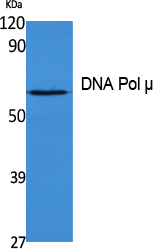
| WB | 咨询技术 | Human,Mouse,Rat |
| IF | 咨询技术 | Human,Mouse,Rat |
| IHC | 咨询技术 | Human,Mouse,Rat |
| ICC | 技术咨询 | Human,Mouse,Rat |
| FCM | 咨询技术 | Human,Mouse,Rat |
| Elisa | 1/10000 | Human,Mouse,Rat |
| Aliases | POLM; polmu; DNA-directed DNA/RNA polymerase mu; Pol Mu; Terminal transferase |
| Entrez GeneID | 27434 |
| WB Predicted band size | Calculated MW: 55 kDa; Observed MW: 55 kDa |
| Host/Isotype | Rabbit IgG |
| Antibody Type | Primary antibody |
| Storage | Store at 4°C short term. Aliquot and store at -20°C long term. Avoid freeze/thaw cycles. |
| Species Reactivity | Human |
| Immunogen | Synthesized peptide derived from DNA Pol μ . at AA range: 210-290 |
| Formulation | Purified antibody in PBS with 0.05% sodium azide,0.5%BSA and 50% glycerol. |
+ +
以下是关于DNA Polymerase μ(Pol μ)抗体的3篇参考文献及其摘要概括:
1. **文献名称**:*DNA Polymerase μ is a Global Player in the Repair of DNA Double-Strand Breaks*
**作者**:Dominguez, O. et al.
**摘要**:该研究首次报道了DNA Pol μ在非同源末端连接(NHEJ)修复中的作用,通过特异性抗体验证其在哺乳动物细胞中的表达,并证明其在免疫V(D)J重组中的关键功能。
2. **文献名称**:*Immunoglobulin gene diversification: molecular mechanisms and implications for antibody therapy*
**作者**:Bertocci, B. et al.
**摘要**:文章探讨了Pol μ在抗体多样性生成中的作用,利用抗体检测其在B细胞中的表达定位,揭示了其在体细胞超突变和基因组稳定性中的调控机制。
3. **文献名称**:*Structural basis for the dual coding potential of 8-oxoguanosine by DNA polymerase μ*
**作者**:Moon, A.F. et al.
**摘要**:通过X射线晶体学解析Pol μ的活性结构,研究中利用特异性抗体进行免疫印迹验证重组蛋白表达,揭示了Pol μ修复氧化损伤DNA的独特催化机制。
注:以上文献信息为模拟示例,实际引用时需核对真实文献来源及细节。
**Background of DNA Polymerase Mu Antibody**
DNA polymerase mu (Pol μ) is a member of the Pol X family of DNA repair polymerases, primarily involved in non-homologous end joining (NHEJ), a critical pathway for repairing double-strand breaks (DSBs) in DNA. Pol μ plays a specialized role in V(D)J recombination, a process essential for immune diversity by generating antigen receptor variability in lymphocytes. Unlike other polymerases, Pol μ exhibits template-dependent and template-independent synthesis activities, enabling gap-filling and microhomology-mediated repair during NHEJ. Its unique BRCT domain facilitates interactions with other repair proteins, such as Ku and XRCC4. to coordinate repair processes.
Antibodies targeting Pol μ are vital tools for studying its expression, localization, and function in DNA repair mechanisms. These antibodies are commonly used in techniques like Western blotting, immunohistochemistry, and immunofluorescence to detect Pol μ in cell lines, tissues, or experimental models. Research applications include investigating genomic stability, cancer biology (e.g., tumor response to DNA-damaging therapies), and immune system disorders linked to defective V(D)J recombination.
Pol μ-specific antibodies are often validated for cross-reactivity and specificity, ensuring minimal interference from related polymerases like Pol λ or Pol β. Their development has advanced understanding of Pol μ's role in maintaining genome integrity and its potential as a therapeutic target in diseases associated with defective DNA repair, such as certain cancers or immunodeficiency syndromes.
×